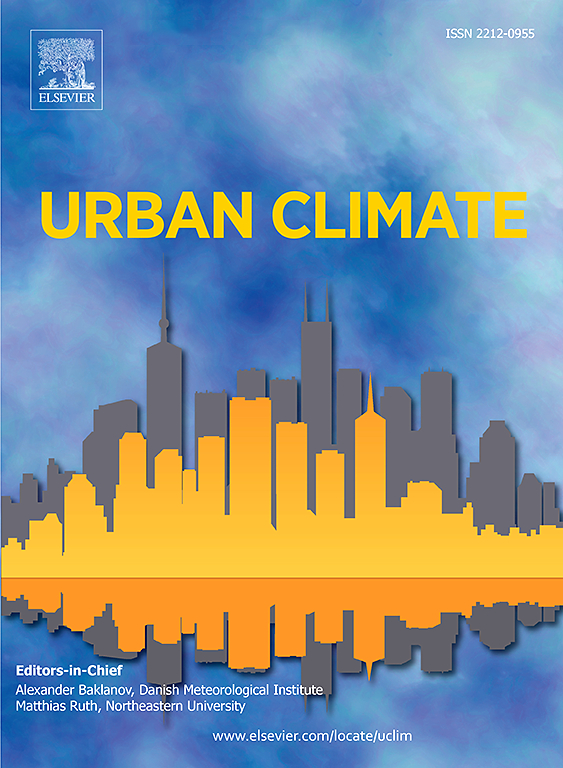The formation characteristics of nitrous acid (HONO) in a central Chinese city: A novel insight from various pollution types
IF 6.9
2区 工程技术
Q1 ENVIRONMENTAL SCIENCES
引用次数: 0
Abstract
Nitrous acid (HONO) is an essential precursor for hydroxyl radical (·OH), exerting a significant impact on atmospheric oxidation chemistry. This study examined the contaminative properties and main sources of HONO across four distinct pollution categories, including a non-pollution period (Period I), a haze pollution period (Period II), an ozone pollution period (Period III) and a double high pollution period (Period IV). Nighttime HONO levels were predominantly driven by the heterogeneous transformation of NO₂ into HONO, with higher reaction rates (CHONO) during Period IV (3.5 × 10−2 h−1) and Period II (3.3 × 10−2 h−1) compared to Period I and Period III (2.0 × 10−2 h−1). This indicates that elevated PM2.5 and NO₂ concentrations enhance HONO production, while automobile exhaust and NO homogeneous reactions had limited influence on nighttime HONO formation. Daytime HONO budget analysis revealed that the unknown source emissions (Punknown) were substantially higher during Period IV (1.21 ppb h−1) than in Period II (0.77 ppb h−1) and Period III (0.57 ppb h−1). Specifically, Punknown demonstrated a more pronounced positive correlation with relative humidity (RH) (R2 = 0.66) and NH3 (R2 = 0.55) during Period IV. Peak Punknown values coincided with warmer daytime periods, when NH₃ emissions and gas-phase HONO formation intensified, enhancing atmospheric oxidation capacity and exacerbating air pollution. The study enhanced the understanding on the pollution characteristics of HONO, which supported the development of targeted policies in the Central Plains Economic Region.

中国中部城市亚硝酸(HONO)的形成特征:来自不同污染类型的新见解
亚硝酸(HONO)是羟基自由基(·OH)的重要前体,对大气氧化化学有重要影响。本研究在四个不同的污染类别中考察了HONO的污染特性和主要来源,包括非污染时期(阶段I)、雾霾污染时期(阶段II)、臭氧污染时期(阶段III)和双重高污染时期(阶段IV)。夜间HONO水平主要由NO₂向HONO的异质转化驱动,与第1和第3周期(2.0 × 10−2 h−1)相比,第4周期(3.5 × 10−2 h−1)和第2周期(3.3 × 10−2 h−1)的反应速率(CHONO)更高。这说明PM2.5和NO₂浓度升高会促进夜间HONO的生成,而汽车尾气和NO均相反应对夜间HONO的形成影响有限。白天HONO预算分析显示,在周期IV (1.21 ppb h−1)期间,未知源排放(Punknown)显著高于周期II (0.77 ppb h−1)和周期III (0.57 ppb h−1)。具体来说,Punknown在第四阶段与相对湿度(RH) (R2 = 0.66)和NH3 (R2 = 0.55)表现出更明显的正相关。峰值Punknown值与较温暖的白天吻合,这时NH₃排放和气相HONO形成加剧,增强了大气氧化能力,加剧了空气污染。该研究加深了对HONO污染特征的认识,为中原经济区制定有针对性的政策提供了依据。
本文章由计算机程序翻译,如有差异,请以英文原文为准。
求助全文
约1分钟内获得全文
求助全文
来源期刊

Urban Climate
Social Sciences-Urban Studies
CiteScore
9.70
自引率
9.40%
发文量
286
期刊介绍:
Urban Climate serves the scientific and decision making communities with the publication of research on theory, science and applications relevant to understanding urban climatic conditions and change in relation to their geography and to demographic, socioeconomic, institutional, technological and environmental dynamics and global change. Targeted towards both disciplinary and interdisciplinary audiences, this journal publishes original research papers, comprehensive review articles, book reviews, and short communications on topics including, but not limited to, the following:
Urban meteorology and climate[...]
Urban environmental pollution[...]
Adaptation to global change[...]
Urban economic and social issues[...]
Research Approaches[...]
 求助内容:
求助内容: 应助结果提醒方式:
应助结果提醒方式:


